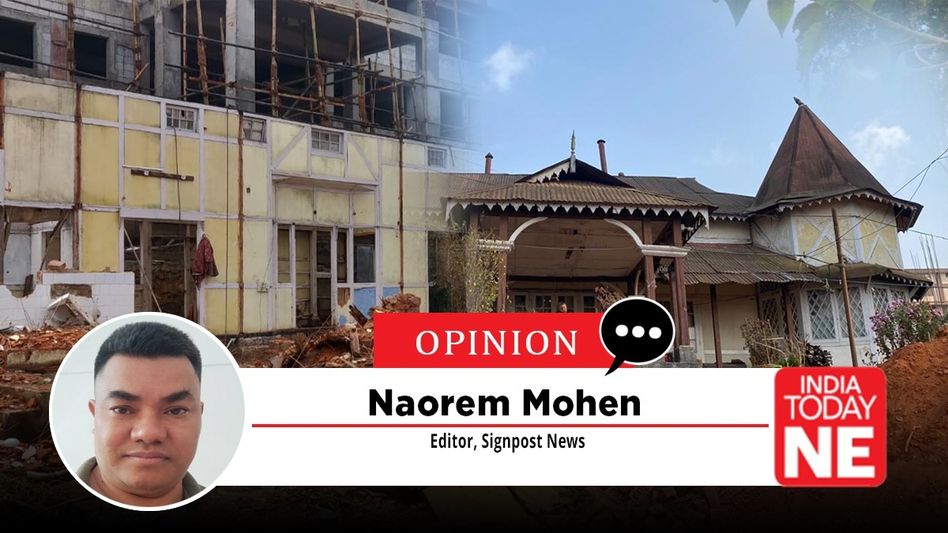Who Bulldozed Red Land in Shillong? The Guilty Must Be Punished Before History Fades
The demolition of Shillong’s historic Red Land Building, known as the Manipur Rajbari, has unleashed a torrent of grief and outrage across Manipur, thrusting the Manipur government into a maelstrom of controversy.

The demolition of Shillong’s historic Red Land Building, known as the Manipur Rajbari, has unleashed a torrent of grief and outrage across Manipur, thrusting the Manipur government into a maelstrom of controversy.
This iconic site, where Maharaja Bodhchandra Singh was coerced into signing the 1949 Manipur Merger Agreement, was not merely a structure but a living testament to Manipur’s sovereign soul—its heritage, identity, and resilience.
The abrupt destruction, carried out over the past 48 hours, has sparked accusations of a deliberate attempt by powerful forces to erase the legacy of Manipur’s annexation into India. As fingers point across state lines, the Manipur government faces intense scrutiny to justify its unauthorized actions, while Meghalaya’s Chief Minister Conrad Sangma has vowed to investigate and hold the culprits accountable.
In 1949, Maharaja Bodhchandra Singh stood powerless as his kingdom was annexed into the Indian Union under duress, confined within the walls of the Red Land Building, or Manipur Rajbari, on Boyce Road in Shillong. Fast forward to 2025, and a second betrayal has struck: we, the people of Manipur, failed to save this sacred site from demolition. The Red Land Building, where the Manipur Merger Agreement was signed on September 21, 1949, has been reduced to rubble, severing a tangible link to the moment that ended Manipur’s independence.
This heart-wrenching destruction, despite desperate pleas from the Manipuri community, is not just the loss of a structure; it is a deliberate burial of our sovereign soul—our heritage, identity, and resilience—leaving a void that echoes with grief and outrage across Manipur. This tragedy is not just a loss of brick and timber; it is a second betrayal of Manipur’s people, demanding justice before their history fades into oblivion.In 1949, the Red Land Building on Boyce Road in Shillong bore witness to a pivotal moment in Manipur’s history.
Maharaja Bodhchandra Singh, the last ruler of a monarchy tracing its roots to 33 AD under King Pakhangba, arrived in Shillong under the pretence of negotiations with the Indian government. Manipur, a kingdom that had endured over 1,900 years of invasions from Burma and the British, sought to preserve its autonomy as India gained independence in 1947.
Bodhchandra, who ascended the throne in 1941 at age 33, had signed a Standstill Agreement with the Dominion of India, allowing internal governance while India managed defence, external affairs, and communications. This arrangement reflected Manipur’s desire to retain its distinct identity within the new nation.
Also Read: From Manipur to Nagaland: Kuki Tribes and the Rise of Indigenous Protectionism
However, the invitation to Shillong proved to be a trap. Confined within the walls of the Red Land Building, Bodhchandra was placed under de facto house arrest, isolated from his advisors and family. Historical accounts paint a harrowing picture: in a dimly lit room with creaky wooden floors, the young Maharaja paced restlessly, grappling with betrayal.
Under intense pressure from V.P. Menon, Secretary in the Ministry of States, he faced a psychological ordeal that culminated in his signing of the Merger Agreement on September 21, 1949. Effective October 15, 1949, this document ceded all governance powers to India, marking the end of Manipur’s independence.
For Manipuris, the Red Land Building—also known as Manipur Rajbari—became a symbol of coercion, its red walls and late colonial design of brick, timber, and Anglo-Assamese elements standing as silent witnesses to the eclipse of their sovereignty.
Built in the early 1930s, the Red Land Building, named for its striking red exterior, was part of the British administrative complex. Its colonial design—polished wooden floors, high ceilings with exposed beams, and wide verandas tailored to Shillong’s misty hills—functioned as a guesthouse and office space for British officials.
For decades, the Rajbari served as a pilgrimage site for Manipuris visiting Shillong. Scholars, activists, and ordinary citizens paid homage, sharing narratives of Bodhchandra’s confinement and the merger’s enduring impact on their identity. During the 1970s and 1980s, amid Northeast insurgencies, the building stood as a potent symbol of unresolved grievances, with many arguing the merger disregarded the State Assembly’s resolutions for autonomy. Its late colonial architecture, blending pre- and post-independence governance styles, marked it as a transitional heritage site, embodying Manipur’s complex history.
The controversy surrounding its demolition erupted into public view during media interaction at the Classic Grande in Imphal today, where Meghalaya Chief Minister Conrad Sangma, currently on a two-day visit, addressed the issue. In a resolute statement, Sangma clarified that his government had issued no permission for the demolition and had explicitly communicated to the Manipur government the importance of preserving the Red Land Building.
He emphasized that neither Meghalaya’s government nor any of its agencies were involved in the demolition activities that transpired over the past 48 hours, placing full responsibility on Manipur government's authorities. Conrad Sangma reiterated his administration’s commitment to safeguarding significant monuments and historic structures, noting that official directives to protect the site were unequivocal.
Expressing concern over the incident occurring in his state, he assured the people of Manipur that he would launch a thorough investigation to hold those responsible accountable, reinforcing his dedication to preserving cultural heritage.
Yet, the question lingers: how could such a travesty occur under the watch of two state governments?The Red Land’s significance cannot be overstated.
On August 12, 2021, during the tenure of former Manipur Chief Minister N. Biren Singh, the 1.93-acre estate was formally transferred from Meghalaya to Manipur for ₹91,04,784, including land revenue dues from 2008. Documented through a possession certificate titled “Patta/Possession Certificate for Manipur Bhawan/Rajbari Shillong bearing Holding No. 67 (earlier 6-72) under Ward No. 3 of the Shillong Municipal Corporation,” the transfer marked the resolution of a decades-long ownership dispute.
N Biren Singh, who was instrumental in the negotiations, expressed gratitude to Meghalaya’s government and announced plans to restore the dilapidated property as Manipur State Bhawan, preserving its legacy and reaffirming Manipur’s cultural heritage. These plans, however, have now been reduced to rubble, along with the hopes of a community that saw the Rajbari as a cornerstone of their identity.
The Manipuri Elders’ Consortium, Shillong (MECS), amplified preservation efforts in recent months. On September 10, 2025, MECS submitted a poignant letter to Michael Achom, IRS, Secretary of the General Administration Department, Government of Manipur, with copies to Laishram Nandakumar Singh, IAS, Director of Art and Culture, and S. Imoshana Meitei, MCS, Deputy Resident Commissioner, Manipur Bhawan, Guwahati.
Signed by the MECS president, the letter highlighted the Rajbari’s historical and emotional value as the site of the 1949 Merger Agreement, noting its poor upkeep despite a sound structure. While grateful for plans for a new Manipur House, MECS urged the restoration of the 90-year-old Rajbari, a site where every Manipuri visitor paid respects, pleading for its preservation.
On September 23, 2025, representatives from MECS and Manipuri Sahitya Parishad Meghalaya met Gyan Prakash, IAS, Commissioner of Arts and Culture, at Imphal Secretariat, advocating for proper restoration and heritage status. The meeting yielded assurances of action, prompting the team to seek support from Rajya Sabha MP Maharaja Leishemba Sanajaoba and former BJP MP Dr. RK Ranjan Singh, reflecting a united community resolve to protect this symbol of identity.
Despite these efforts, contractors razed the Red Land Building without notice, defying pleas from Leishemba Sanajaoba and Dr. RK Ranjan Singh to Manipur Governor Ajay Kumar Bhalla and violating Article 49 of the Constitution and the 1958 Act, which mandate the protection of historic sites.
The demolition is a heartbreaking setback, undermining gestures by the Central government to honor Manipur’s proud history. The renaming of Mount Harriet in the Andaman Islands to Mount Manipur, commemorating exiled leaders like Maharaja Kulachandra who fought the British, and the unveiling of INS Imphal in the Indian Navy’s war fleet symbolize recognition of Manipur’s contributions to the nation.
Yet, the destruction of the Red Land Building severs a tangible link to the 1949 merger’s painful legacy, contradicting these efforts to celebrate Manipur’s heritage. For Manipuris, this is not just the loss of a building but a deliberate burial of their sovereign soul—a wound that echoes the betrayal of 1949, when Maharaja Bodhchandra was coerced into submission.
The alleged role of Manipur government in this tragedy has raised troubling questions. The unauthorized demolition, carried out despite clear directives to preserve the site, suggests either gross negligence or a calculated move by influential forces to erase a contentious chapter of history.
The 1949 merger remains a sensitive issue, with many Manipuris viewing it as an annexation rather than a voluntary union. The Red Land Building, standing for decades as a reminder of that fraught moment, was a space where narratives of resistance and identity were kept alive.
This irreplaceable monument has been erased from the earth, demolished by contractors in a callous act that reflects a profound indifference to Manipur’s historical legacy. Its destruction feels like an attempt to silence those painful history, to bury the unresolved grievances that have fueled debates and movements in Manipur for generations.This tragedy demands more than investigations—it demands justice.
The guilty must be punished, and immediate action is needed to restore or commemorate the Rajbari’s legacy. Whether through reconstructing the site, establishing a memorial, or pursuing legal accountability, the Manipur government must answer for its actions.
The Central government, which has shown sensitivity to Manipur’s history, must intervene to ensure such erasures do not recur. The Red Land Building was more than a structure; it was a repository of Manipur’s soul, a testament to its resilience and identity. Its loss is a call to action, a plea to ensure that Manipuri heritage endures for generations to come, before it fades into the silent hills of Shillong forever.
Copyright©2025 Living Media India Limited. For reprint rights: Syndications Today









